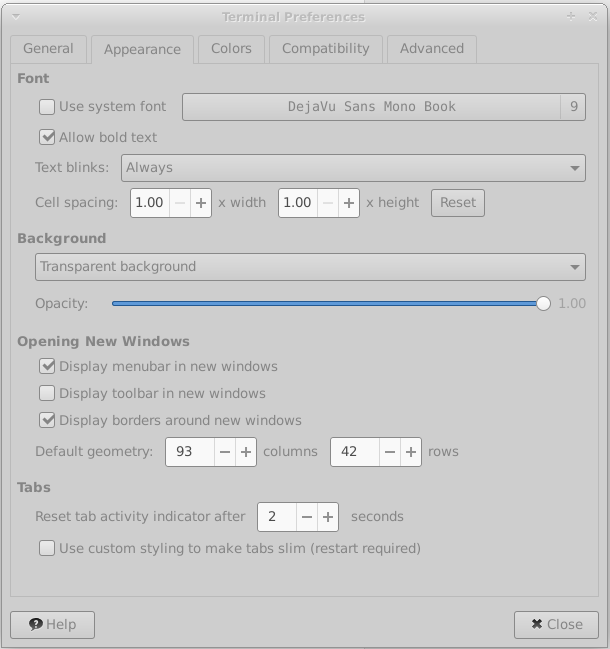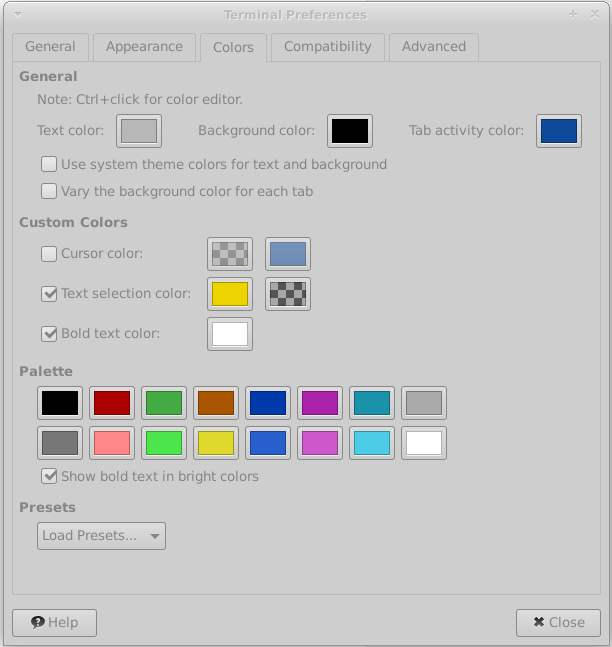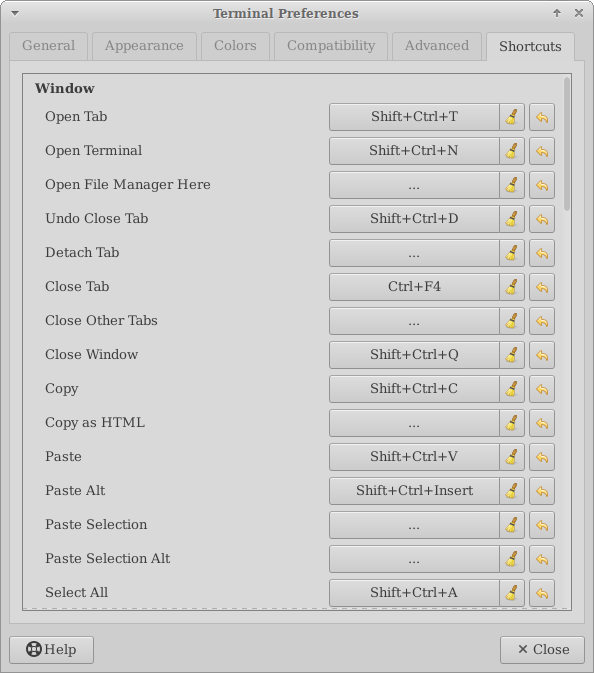
xfce4-terminal - Preferences
To configure Terminal, choose Edit → Preferences... or right-click the terminal area of the window and choose Preferences.... This will bring up the Terminal Preferences dialog, which allows you to adjust Terminal's behaviour to your needs.
To change the application shortcuts, read the FAQ section Editable Menu Accelerators.
| Open Terminal Preferences Menu Dropdown |
|---|
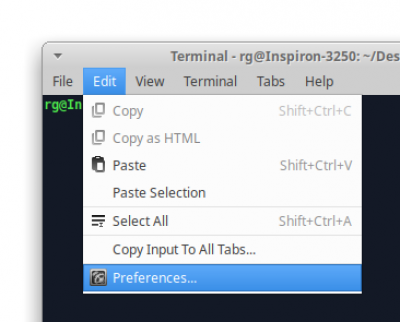
|
General
Title
- Initial title
- Use this text box to specify the initial title of terminals. New terminals will have the initial title.
- The initial title can also substitute some tokens, see the section called To change the terminal title for more information.
- Dynamically-set title
- Use this drop-down list to specify how to handle dynamically-set titles, that is, terminal titles set by the commands that run in the terminal.
Command
- Run command as login shell
- Select this option to force Terminal to run your shell as a login shell when you open new terminals. See the documentation of your shell for details about differences between running it as interactive shell and running it as login shell.
- Update utmp/wtmp records when command is launched (removed in 0.8.0)
- Select this option to insert a new entry in the utmp and wtmp records when a new terminal is opened.
Scrolling
- Scroll on output
- Select this option to enable you to scroll the output on the terminal while the terminal continues to display more output from a command.
- Scroll on keystroke
- Select this option to enable you to press any key on the keyboard to scroll down the terminal window to the command prompt. This action only applies if you scrolled up the terminal window and you want to return to the command prompt.
- Scrollbar is
- Use this drop-down list to specify the position of the scrollbar in terminal windows.
- Scrollback
- Use this spin box to specify the number of lines that you can scroll back using the scrollbar or the mouse wheel. For example, if you specify 1000 you can scroll back the last 1000 lines displayed in the terminal.
- Unlimited scrollback (since 0.8.0)
- Use this checkbox to set unlimited scrollback capacity.
Appearance
Font
Click on the button to select the font type and font size you want to use for the terminal.
Background
Select a background for the terminal window. The options are as follows:
- None (use solid color)
- Select this option to use the background color that is specified in the Colors section as the background color for the terminal.
- Background image
- Select this option to use an image file as the background for the terminal. Use the Image file entry box to specify the location and name of the image file. Alternatively, click on the button besides the entry box to search for and select the image file.
- Use the Style option to control the appearance of the background image. Terminal supports tiling, centering, scaling and stretching background images.
- Transparent background
- Select this option to use a transparent background for the terminal.
If you have selected Background image or Transparent background, you can use the slider Shade transparent or image background to shade or dim the background of the terminal.
Opening new windows
- Display menubar in new windows
- Select this option to show the menubar on new terminal windows by default.
- Display toolbars in new windows
- Select this option to show toolbars on new terminal windows by default.
- Display borders around new windows
- Select this option to show window decorations on new terminal windows by default.
- Default size
- The default terminal geometry in rows and columns.
Tab Activity Indicator
The time in seconds a non-active tab title will be highlighted in the Tab activity color, you can set in the Colors tab. If the time expired and the tab is not visited yet, the color will be changed to the color between the activity color and the normal text color defined by the theme.
To disable this feature, set the time to 0.
Colors
General
- Text color
- The color to draw normal text. An application running inside the terminal can also request a different color chosen from the palette below to draw text.
- Cursor color
- The cursor color.
- Background color
- Choose the default background for terminal windows. This color is also used in background tinting when Transparent background or Background image is selected.
- Tab activity color
- This color is used to indicated activity in non-active tabs. See also the option in the Appearance settings.
- Vary the background color for each tab
- Choose a random color based on the selected background color. The Hue value will be randomly chosen. Saturation will be random as well, clamped +/- 20% of the original value. The Value won't be modified, to make sure the new color will have the same brightness. This means the random color will be less efficient with dark colors (black is always black, because the Value = 0).
Custom Colors
- Text selection color
- By default the text and background colors will be reversed for selected text. You can set a custom selection background color by enabling the option and choosing a color.
- Bold text color
- By default the color color is the same as the text color. You can override this by enabling the option and choosing a color.
Palette
The terminal provides the application running inside with a palette of 16 colors. You can customize these colors using the 16 color buttons. To show the palette combinations, run xfce4-terminal --color-table in a window.
Presets
Load default presets. The preset will set the colors and options defined in the file or reset them to the default value.
Compatibility
| Terminal Prefereneces Compatibility Tab |
|---|
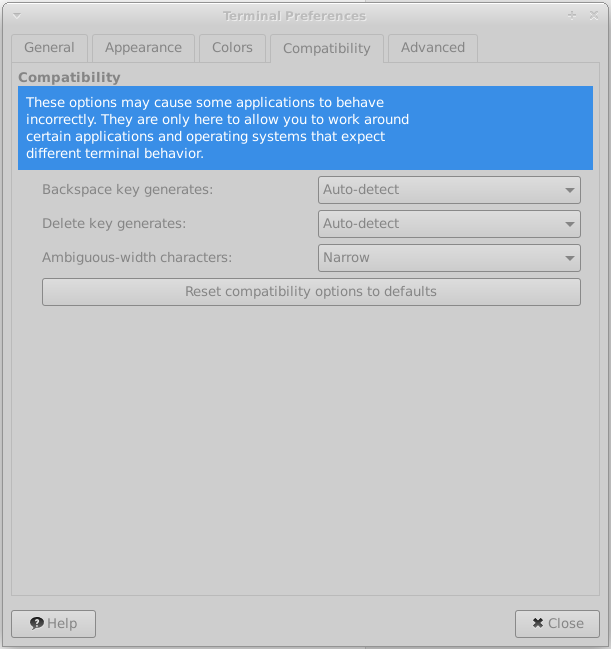
|
- Backspace key generates
- Use the drop-down list to select the function that you want the Backspace key to perform.
- Delete key generates
- Use the drop-down list to select the function that you want the Delete key to perform.
- Ambiguous-width characters
- Dropdown list option choice between narrow and wide.
- Reset compatibility options to defaults
- Click this button to reset the options on the Compatibility tabbed section to its defaults settings.
Advanced
Double Click
Encoding
Choose the default encoding for the terminal. You can temporarily override this using the Terminal → Set Encoding menu in the menubar.
Menubar Access (Shortcuts in 0.8.0)
- Disable all menu access keys
- Select this option to disable the access keys, the so called mnemonics such as Alt-f, that are defined to enable you to use keyboard instead of the mouse to select a menu item. Each access key is identified by an underlined letter on a menu or dialog option. In some cases, you must press the Alt key in combination with the access key to perform the action.
- Do not confuse this with accelerators like Ctrl-Alt-N. You have to manually disable those by removing them as explained in the Editable Menu Accelerators section of the FAQ.
- The reason accelerators and mnemonics are handled seperatly is because mnemonics are hard-coded by the translations. Accelerators on the other hand can be removed or edited by the user. So you can yourself change those so they don't cause any conflicts with applications you run inside the terminal.
- Disable menu shortcut key (F10 by default)
- Select this option to disable the shortcut key that is defined to enable you to access the Terminal menus. The default shortcut key to access the menus is F10.
- Disable help window shortcut key (F1 by default) (since 0.8.0)
- Select this option to disable the shortcut key that is defined to open the help window. The default shortcut key for that is F1.
Misc (since 0.8.0)
- Use middle mouse click to close tabs
- Select this option to enable closing terminal tabs with middle mouse click.
- Auto-hide mouse pointer
- Select this option to hide mouse pointer when typing in the terminal.
- Rewrap terminal contents on resize
- Select this option to allow re-wrapping of the terminal contents when resizing the window. If disabled, the contents that does not fit into the window will become invisible.

